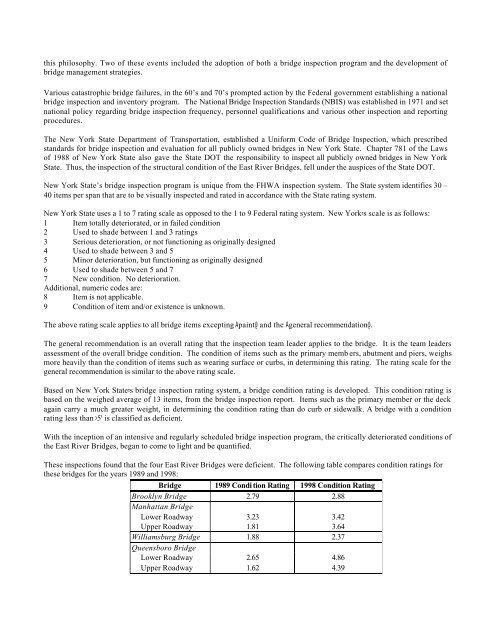MANAGING THE EAST RIVER BRIDGES IN NEW YORK CITY
MANAGING THE EAST RIVER BRIDGES IN NEW YORK CITY
MANAGING THE EAST RIVER BRIDGES IN NEW YORK CITY
Create successful ePaper yourself
Turn your PDF publications into a flip-book with our unique Google optimized e-Paper software.
this philosophy. Two of these events included the adoption of both a bridge inspection program and the development of<br />
bridge management strategies.<br />
Various catastrophic bridge failures, in the 60’s and 70’s prompted action by the Federal government establishing a national<br />
bridge inspection and inventory program. The National Bridge Inspection Standards (NBIS) was established in 1971 and set<br />
national policy regarding bridge inspection frequency, personnel qualifications and various other inspection and reporting<br />
procedures.<br />
The New York State Department of Transportation, established a Uniform Code of Bridge Inspection, which prescribed<br />
standards for bridge inspection and evaluation for all publicly owned bridges in New York State. Chapter 781 of the Laws<br />
of 1988 of New York State also gave the State DOT the responsibility to inspect all publicly owned bridges in New York<br />
State. Thus, the inspection of the structural condition of the East River Bridges, fell under the auspices of the State DOT.<br />
New York State’s bridge inspection program is unique from the FHWA inspection system. The State system identifies 30 –<br />
40 items per span that are to be visually inspected and rated in accordance with the State rating system.<br />
New York State uses a 1 to 7 rating scale as opposed to the 1 to 9 Federal rating system. New York=s scale is as follows:<br />
1 Item totally deteriorated, or in failed condition<br />
2 Used to shade between 1 and 3 ratings<br />
3 Serious deterioration, or not functioning as originally designed<br />
4 Used to shade between 3 and 5<br />
5 Minor deterioration, but functioning as originally designed<br />
6 Used to shade between 5 and 7<br />
7 New condition. No deterioration.<br />
Additional, numeric codes are:<br />
8 Item is not applicable.<br />
9 Condition of item and/or existence is unknown.<br />
The above rating scale applies to all bridge items excepting Apaint@ and the Ageneral recommendation@.<br />
The general recommendation is an overall rating that the inspection team leader applies to the bridge. It is the team leaders<br />
assessment of the overall bridge condition. The condition of items such as the primary memb ers, abutment and piers, weighs<br />
more heavily than the condition of items such as wearing surface or curbs, in determining this rating. The rating scale for the<br />
general recommendation is similar to the above rating scale.<br />
Based on New York State=s bridge inspection rating system, a bridge condition rating is developed. This condition rating is<br />
based on the weighed average of 13 items, from the bridge inspection report. Items such as the primary member or the deck<br />
again carry a much greater weight, in determining the condition rating than do curb or sidewalk. A bridge with a condition<br />
rating less than >5' is classified as deficient.<br />
With the inception of an intensive and regularly scheduled bridge inspection program, the critically deteriorated conditions of<br />
the East River Bridges, began to come to light and be quantified.<br />
These inspections found that the four East River Bridges were deficient. The following table compares condition ratings for<br />
these bridges for the years 1989 and 1998:<br />
Bridge 1989 Condi tion Rating 1998 Condition Rating<br />
Brooklyn Bridge 2.79 2.88<br />
Manhattan Bridge<br />
Lower Roadway 3.23 3.42<br />
Upper Roadway 1.81 3.64<br />
Williamsburg Bridge 1.88 2.37<br />
Queensboro Bridge<br />
Lower Roadway 2.65 4.86<br />
Upper Roadway 1.62 4.39
















